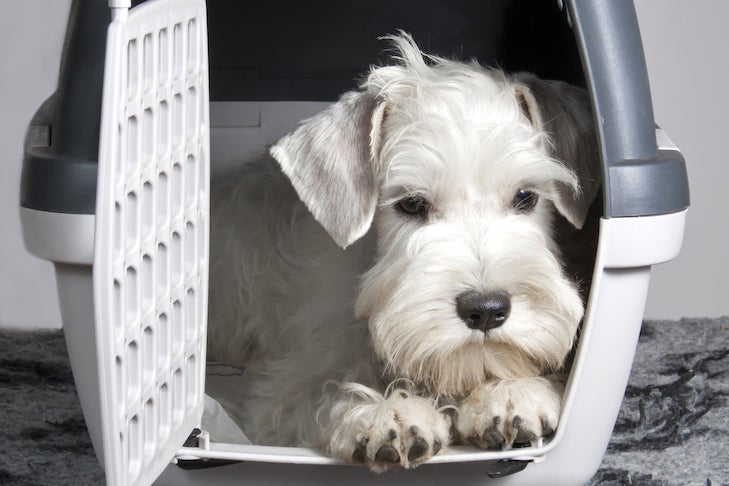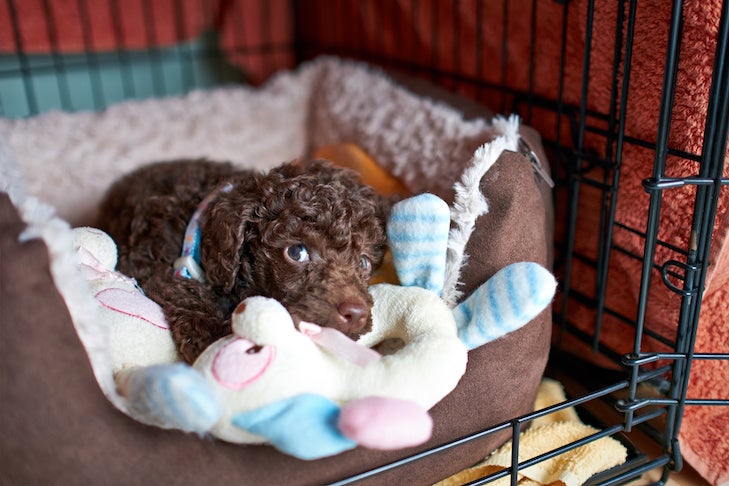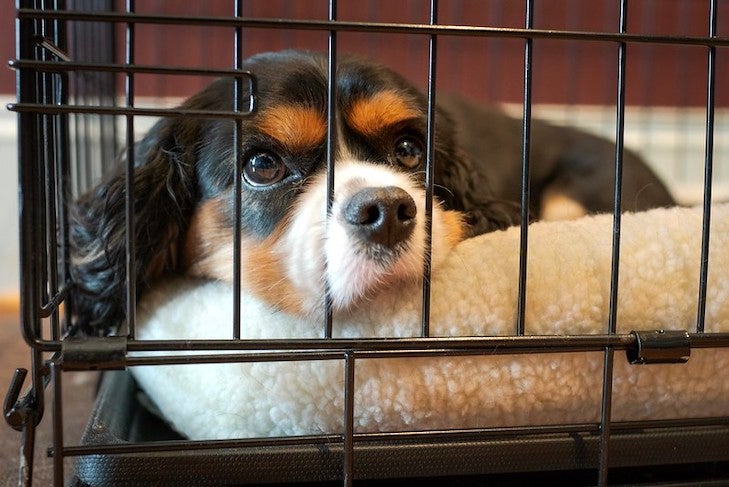AKC is a participant in affiliate advertising programs designed to provide a means for sites to earn advertising fees by advertising and linking to akc.org. If you purchase a product through this article, we may receive a portion of the sale.
AKC GoodDog! Helpline is our telephone and video dog training consultation service. We offer live, personalized assistance with your questions about training your puppy or dog. To celebrate the service’s 10th anniversary, we’ve rounded up the most common questions that our dog trainers hear from owners just like you. In this edition: “How do I crate train my dog?”
Your dog’s crate is their personal den, a place to relax, sleep, and feel safe. Crate training has many benefits, like implementing a routine for your dog and helping regulate their potty training schedule. It’s also an important tool to teach your dog how to be alone. But how do you safely and effectively use a crate without making your dog feel like you’re punishing them?
Whether you have a new puppy or an adult dog, with the right approach, you can train them to feel comfortable in their crate. Making sure you choose the right crate size for your dog is also an important part of successful crate training. These 10 tips will help make crate training your dog a positive and successful experience. Soon, your dog will look forward to spending time in a private space that’s entirely theirs.
1. Encourage Your Dog to Explore Their Crate
When you first expose your dog to a crate, they might be anxious and not want to go inside. Try to avoid forcing your dog into the crate, since that can create a negative association. If your dog is afraid of going inside an enclosed space, pushing them to go in will only make them more nervous. This might make your dog have negative feelings or fears about the crate, which are harder to unlearn.

Instead, encourage your dog to enter and explore on their own. A perfect way to do that is to lay a trail of dog food or training treats that leads to the crate. Hold the crate door open, so it doesn’t accidentally close on your dog. These early associations will greatly impact how your dog sees the crate — first impressions matter!
If your dog is hesitant, encourage them to go a bit farther each time you lay the trail until they finally feel confident about going inside. Patience is key: your dog is trying to understand something new. Make sure to wait to close the door behind them when they are voluntarily going in and out on their own. If you close the door too early on, they may also react negatively and feel trapped in this new space.
2. Create Positive Associations with the Crate
Your dog’s crate is an effective tool to help keep them out of trouble, but you don’t want them to feel like they’re being put in a time-out either. Make it a priority to create a positive association every time you use the crate, so your dog only has positive feelings when they’re going in it. This can mean offering a favorite dog treat for entering, keeping a bully stick or other high-value chew inside, or giving your dog lots of praise.
These incentives and positivity towards the crate will help your dog see the crate as a place they want to be. Instead of punishment, you want to establish crate time to let them calm down. If they see it as a place where they feel safe and can relax, it’ll be more effective to also prevent unwanted dog behavior.
3. Reward Calm Behavior in the Crate
Once your dog is happily spending time inside their crate, it’s important not to take that for granted. Dogs repeat behaviors that are rewarded, and calm, quiet relaxation is exactly what you want. If you reinforce that this is what you want your dog to be doing, they’ll keep doing it, knowing that it makes you happy and they get a reward out of it.
Make your expectations clear by rewarding your dog when they behave calmly in the crate, or willingly go to the crate on their own to rest or relax. These rewards could be anything from gentle praise to a dog biscuit. Try to reward your dog in a way that keeps them relaxed, since you want to avoid riling them up again after they’ve gone to their calm place by their own choice.

4. Keep Rewards Near the Crate
To reinforce crate training and proper behavior in the crate, you’ll want to provide a reward in the moment. If praise is associated with going in the crate, they’re more likely to make the connection that this is what you want them to do. If you need five minutes to dig out treats from the bottom of your kitchen cupboard, your dog may have become bored by then, and try other behaviors, like barking or pawing at the crate door, to get your attention.
Rewarding your dog promptly to make that positive connection to their crate means you’ll want to have those rewards close by. Keep a sealed container of kibble, a small dog treats, or some crate-only chew toys right near the crate so you can reinforce this good behavior right after it happens.
5. Practice Positive Dog Crate Cues
It’s helpful to teach your dog to enter their crate on cue, especially if you’re traveling with your dog or faced with an emergency evacuation with your dog. Even in an everyday situation where you need to answer the door, or you need your dog to stay calmly in another room, teaching the cue “crate” or “kennel up” can tell your dog when you want them to go inside. If you practice using the verbal cues before your dog enters the crate, then reward them once they’re inside, soon they will associate the cue with the action, and you can begin to ask for the behavior.
Try to give crate-related cues to your dog in a happy or neutral tone of voice. You want your dog to be excited about entering, not worried that something bad is about to happen or that they’re in trouble. This way, you’ll be able to maintain positive associations with the crate. Even in a stressful situation where you need your dog to go into their crate, try to give the cue neutrally. Your dog will sense your stress in your voice, and if you are consistently telling your dog to go to their crate in this stressful tone, they will also associate stress with their crate.
6. Feed Your Dog Inside Their Crate
Another way you can encourage your dog to explore their crate is by feeding them their regular meals inside the crate. You can do this by putting their dog food bowl in the back of the crate. This will help build a positive association between the crate and food in your dog’s mind.
Most dogs look forward to eating, so if their crate also becomes the place where they have their regular meals, they’ll look forward to being in their crate at meal times. If your dog is reluctant to enter the crate, even to eat, you can start off with the food dish in front of the door. Then, with each meal, slowly move the bowl farther and farther inside. Be patient with your dog — it’s possible that they will need more time to get used to eating in the crate. You may need to keep the bowl in certain spots first before moving it further into the crate.
7. Provide Dog Toys in the Crate

It’s important to give your dog something to do inside their crate, particularly when you are still teaching a dog to settle down and relax. Enjoying a food-stuffed dog toy is a perfect in-crate activity. (You can combine in-crate mealtimes with this toy activity by stuffing your dog’s regular kibble or canned food into a toy. Soaking kibble with some no-salt broth can help it stay put, or you can freeze the toy to give your dog more challenge.) Your dog can interact with the toy while receiving delicious rewards. This builds even more positive associations, teaches your dog appropriate chewing behavior, and gives them something to do.
For example, your dog might enjoy gnawing on a chew toy filled with a spreadable, dog-safe peanut butter snack. They might also have fun playing with interactive dog toys. You can hide small, crunchy treats in a treat dispenser or puzzle toy or game, then watch your dog have fun while trying to find the snacks. (Puzzle toys sometimes have smaller parts, so be sure to supervise your dog while they enjoy puzzle playtime in their crate.)
Be sure you’re choosing the right chew toys for your dog, especially if they will be in their crates unsupervised. They should be large enough that your dog can’t swallow them whole, and tough enough (or soft enough) for your dog’s chewing style. A power chewer, for example, can tear through plush toys in minutes, and pieces of torn-up toys can be a choking hazard. Any time you provide your dog with a new style of toy, supervise them as they play to be sure it’s a safe choice for them.
8. Use More Than One Crate
It can be helpful to provide your dog with different crates for different purposes, rather than expecting one crate in one location to meet all your needs. For example, your dog should have a crate in a quiet part of your home for resting and sleeping, especially if you want them to sleep in a crate overnight. You might opt for this sleeping crate to be in your bedroom or near your bedroom. When you’re potty training, you might also consider putting another crate near a door that goes outside. You could opt to put a crate in the dining room if you don’t want your dog to feel lonely while you eat.
Start with one crate, and once your dog is comfortable with it and sees the crate as their own safe space to hang out, they’ll be more open to other crates in different areas. They’ll hopefully learn to see these crates as places of relaxation, so they’ll feel comfortable having their own space in different rooms of the house. This training will also carry over to when your dog might visit dog daycare, visit friends’ homes, go on overnight vacations with you, or any number of other scenarios where access to a crate can help them feel comfortable and safe.

9. Avoid Crating Your Dog With Force or Anger
If you catch your dog destroying your house or jumping on visitors, it’s tempting to get frustrated and banish them to their crate. While there’s nothing wrong with giving your dog time and space away from trouble, it’s important to do so calmly and gently. Especially if you often use this tone to send your dog to their crate, they will associate it with a place of punishment. Over time, they won’t be calm when they’re in their crate, but rather nervous that they’ve done something wrong and upset you.
After all, you don’t want to ruin all the positive associations you worked so hard to create. If your dog links the crate with your anger, they will stop seeing it as a safe area, and you will have trouble getting them inside next time. It’s the opposite of what you want for your dog when crate training them.
10. Let Your Dog Out Once They’re Calm
Remember that dogs repeat behaviors that are rewarded. If your dog wants out of their crate and you open the door, whatever they were doing at that moment will suggest to them that the behavior was the key to release. If that was barking or whining, they will bark or whine next time they want out, and that’s not what you want. You want them to connect calm behavior as release, so that they continue to model calm behavior in their crate.
You don’t want to undo all the hard work you did to build up calm crate behavior. Instead, before opening the door, ask for a calm behavior, such as having your dog sit or lay down. Slowly delay opening the door for longer and longer periods of time until your dog will patiently wait for you to open it.
If you’re working on potty training, watch the clock or look for signals your puppy needs to relieve themselves before they begin whining because they feel the urge to go for a potty break. Help them be successful by taking them out before they need to whine to let you know it’s urgently time to go.
If you need expert advice from experienced trainers or have additional dog training questions, visit the AKC GoodDog! Helpline page for an online chat or to sign up for the program.
AKC GoodDog! Helpline is celebrating ten years of supporting dog owners. If you need support, experts at AKC GoodDog! Helpline are available by phone or video to answer any training questions that come up, from housetraining your puppy to unwanted behaviors in senior dogs. Join the nearly one million dog owners who trust AKC GoodDog! Helpline today.

